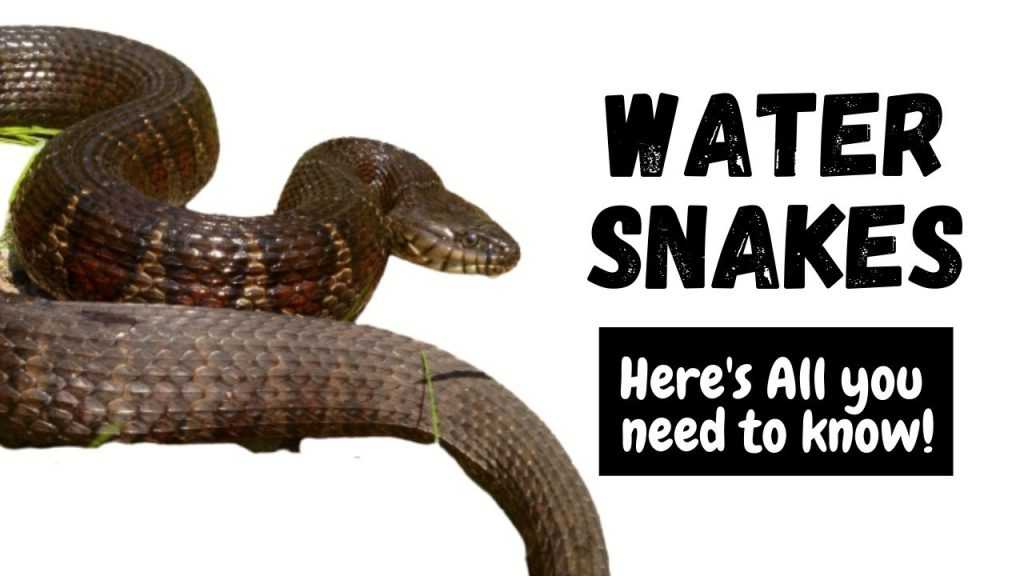Water snakes are the nonvenomous snakes belonging to the Colubridae family and Norodia genus. Water snakes are native to North America and they have significant similarities with the species cottonmouth which are venomous snakes. The cottonmouth snakes are from the same genus but a different family called Viperidae. There are 10 species of water snakes with a few subspecies as well.

Habitat of the Water Snakes
As their name suggests, water snakes are the aquatic snakes that love being in or around the water. They prefer living near a pond, river, stream, or any source of water. They like quiet water sources.
The water snakes are found abundantly in southern and eastern America. The countries like Florida, Alabama, Mississippi, Georgia, California, Arkansas, Carolina, Iowa, and Illinois are outnumbered with massive water snakes.
Physical Characteristics of the Water Snakes
Water snakes are often confused with the venomous cottonmouths and hence get killed. The following physical features will clear this confusion.
Size
The water snakes are small to medium species with a length ranging from 3 to 5 feet. The females grow faster than males and are also heavier and longer than the male snakes.
Skin
The water snakes have rough skin with keeled scales. The raised ridge down the center makes their body feel rough. They also have dark-colored blotches and bands on their backs.
Colours
The colors of the water snakes are various. Mainly, they are found in red, grey, green, brown, and olive green colors. When the snake comes out from the water, it looks like black or dark brown.
Head and neck
The head and neck of the water snakes differentiate them from cottonmouths. The water snakes have a long and thin body with a narrow head and less distinctive neck. On the other hand, the cottonmouths have a thick stocky body, with a heavy and blocky head, and a distinctive neck.
Eyes
The water snakes possess rounded eyes with round pupils. Some species have large eyes.
Life Span
The average life span of the water snake is 9 to 12 years.
Species of the Water Snakes
There are 10 species of water snakes with various subspecies. Some of them are discussed below.
Northern Water Snakes
Northern Water Snakes are the most common species of water snakes. They resemble the cottonmouth snakes the most and has a scientific name as Nerodia sipedon.
The fully grown adult Northern water snakes measure about 2 to 4.5 feet long with an average length of 3.5 feet. They are found in brown, tan, buff, and grey colors with dark blotches on their back.
Northern water snakes live in aquatic habitats and like to eat aquatic animals like fish and frogs.
They are only active in spring and fall. The rest of the year they remained coiled, basking in the sun. They are mostly found in the aquatic regions like pools and ponds of the Northeastern United States, Midwest, Kansas, southern Ontario, Mississippi, and Georgia.
Brown Water Snakes
The Brown Watersnake is a distinctive species of water snakes. The scientific name for this species is Nerodia taxispilota.
This is a medium-sized snake species with a length ranging from 4 to 5 feet. Females are longer than males and can be twice as long as the males.
These snakes appear with a light to medium and dark brown colors. They also have square blotches on their back and sides. They have yellow or brown bellies.
The Brown water snakes have a distinctive wide and diamond-shaped head with large eyes. This appearance often confuses them with other snake species like the venomous rattlesnake and water moccasin.
The Brown water snakes share the same habitat as the banded water snakes. The brown water snakes are exceptionally arboreal and spend most of their time on the trees above the rivers and water sources.
Banded Water Snakes
The Banded water snake is also known as a Southern watersnake with a scientific name as Nerodia fasciata.
The Banded water snake is a species with medium length ranging from 2 to 4 feet. They have a dark brown or greyish body with dark crossbands on the back. The crossbands are wider at the back and narrower at the sides. As this species grows, it becomes darker and sometimes the dark crossbands nearly get disappeared.
They like to eat fish and frogs and are found in Southeastern coastal United States, Alabama, and North Carolina.
Yellow-bellied Water Snakes
The Yellow-bellied water snake is the subspecies of the plain-bellied water snakes. The snakes of these species have no markings on their bellies. The yellow-bellied water snakes are known with a scientific name as Nerodia erythrogaster flavigaster.
The yellow-bellied water snakes are heavy-bodied, semiaquatic species of medium length, ranging from 3 to 4 feet. They have dark green, grey, or brown body with a sparsely patterned back and yellowish underside.
The Yellow-bellied water snakes are mostly found in the Gulf Coast region, Georgia, Texas, and southern Iowa.
Behavior and Habits of the Water Snakes
The water snakes are considered as bad pets. Although they are nonvenomous, they get aggressive and start hissing and biting when someone tries to handle or touch them. It secretes a smelly musk and often vomits when approached or touched by humans.
The water snakes are solitary species and like to climb on the trees over the river to bask. They are diurnal, which means that they hunt at day time and take rest at night. They are social before and after hibernating in the winter.
When they are in the water, only their head remains at the surface of the water and the rest of the body remains hidden and submerged in the water.
Feeding and Hunting of the Water Snakes
The water snakes are aquatic snakes that live in or near water and also like to have aquatic food. In the beginning, the young water snakes like to have fish, preferably slow-moving fish. As they grow and become adults, their taste changes, and they start hunting frogs and similar large sized-animals instead of fish.
The common food items liked by the water snake species are trout, sunfish, smallmouth bass, southern-leopard frogs, bullfrog, minnows, bullhead catfish, northern-cricket frogs, and many of the tadpoles and toads at a time.
The water snakes remain in the water with open mouths and wait for the prey. As the prey passes nearby, they strike the prey with their sharp jaws and make the prey injured. They swallow the whole prey once it is dead.
Reproduction of the Water Snakes
The Water snakes are ovoviviparous. The eggs incubate inside the body of the female snakes and they give birth to live young.
The mating season of watersnakes starts after incubation in spring. Some snakes also mate in the fall but this happens very rarely. The male snakes approach females. One or two males mate with one female in one season.
Females give birth to 15 to 20 live young after four to five months in summer.
Final Words
The Water Snakes are nonvenomous and beautiful snakes and could be good pets but their ‘touch me not’ behavior does not make them suitable to keep them as pets.
[box type=”shadow” align=”” class=”” width=””]
Other Snakes from the Colubridae family we’ve REVIEWED:
[tie_list type=”lightbulb”] [/tie_list] [/box]






